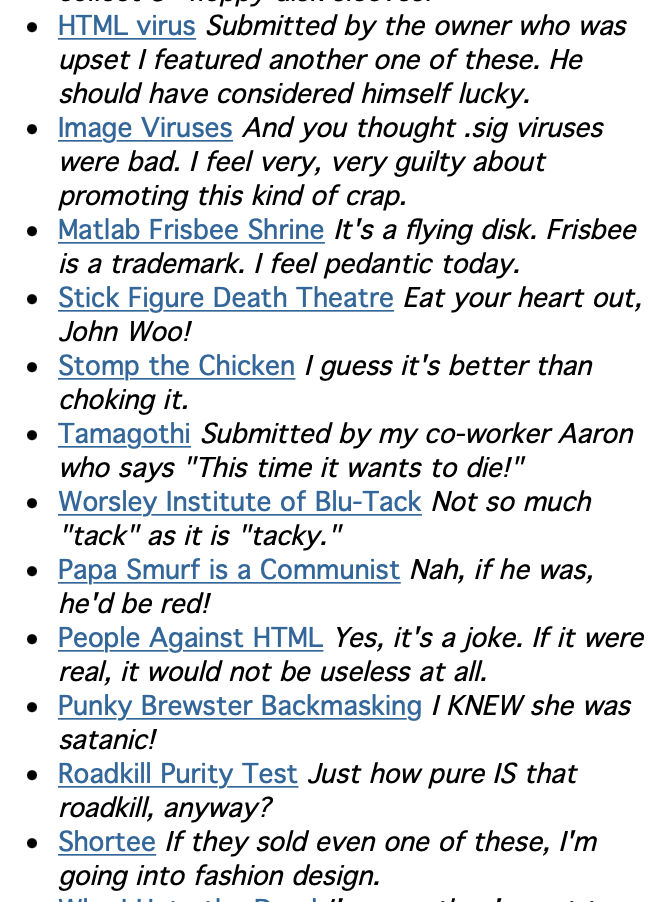In the beginning, the web was going to do, well, nothing at all really. “There’s a staggering amount of uselessness all over the Web,” read one article from Wired from 1996. And that was true then. Seen from the right angle, it’s true now as well.
A decade after that article came out, another article was published in Wired entitled “The Long Tail.”. It was written by technologist and TED founder Chris Anderson. In it, Anderson argued that the widespread and limitless distribution potential of the Internet made it possible to commoditize and make a profit from niche, small-market products with much smaller audiences than mainstream, brick and mortar retailers. “Hit-driven economics is a creation of an age without enough room to carry everything for everybody. Not enough shelf space for all the CDs, DVDs, and games produced,” Anderson argued, continuing, “This is the world of scarcity. Now, with online distribution and retail, we are entering a world of abundance. And the differences are profound.” That’s what he called the Long Tail.
But the Long Tail applies to content on the web more generally. It’s nearly impossible to get an accurate count, but by some estimates, there are over a billion websites (maybe close to two billion). For every website on the top 100 list that you come across on a daily basis, there are hundreds of thousands of websites with far less attention serving some small, niche purpose. Some serve barely any purpose at all.
Paul Phillips once described one of these websites—Kenny Z’s CD List—which he first stumbled upon in 1994. “Its utility was nil, its style banal, its content embarrassing, its unintentional humor value high.” Phillips was nevertheless intrigued that someone would create a website seemingly only for themselves—and equally fascinated by how much time he spent on it. He created his own webpage with a list of websites common only in how useless their premise was. At first, he called it, America’s Funniest Home Hypermedia, but soon changed it to the much more enduring Useless Pages.
One by one, Phillips began to add to the list of useless websites. He’d post a link to a page, and leave a brief comment on it. There wasn’t much rhyme or reason to the list, one site didn’t connect to the other. It was a simple format. Website. Snarky comment. Website. Snarky Comment.

The list continued to grow, and spread, across the web. Within a year, it was reaching tens of thousands of hits a month, which at the time, was a significant portion of all web users. Phillips continued to add new sites, but it was inconsistent and uneven. Through his contact info listed on the site, people were submitting all kinds of useless sites (a look at the earliest sites listed includes a digital vacuum cleaner museum, a catalog of Dutch traffic signs, and a list simply known as “Things Michel like to consume”), but Phillips was unable to keep up. It wasn’t until Steve Berlin took over that the Useless Pages got its full shape.
Berlin came to the web early, in the early ’90’s when a friend from college opened up a browser and showed him the web. By the time Phillips launched The Useless Pages, Berlin was already versed in some of the web’s more obscure corners. He knew where you could find a fan page dedicated to sporks or a page that listed out all the stuff in some guys’ room. He knew the useful stuff too, but he reveled in the useless.
Early on in Useless Pages history, Berlin would email Phillips with lots of recommendations. So, in 1995, Phillips offered to let him run it instead. Berlin accepted, and began to put together a new iteration of Useless Pages, one filled with the same kind of banal niche websites, but with more regularity and a consistent voice.
His web surfing career continued not long after he started maintaining The Useless Pages, when Berlin got hired as Yahoo!’s first full-time web surfer (under the direction of Srinija Srinivasan) in 1995, digging up sites of the more targeted variety and cataloging them in the Yahoo! directory. On top of that, Berlin contributed a bi-monthly column to Websight magazine, alongside fellow columnist and cool site collector Glenn Davis, with more interesting web finds.

By the second half of the 1990’s, Berlin had become something of an expert web surfer.
And through it all, he contributed hundreds and hundreds of new sites to the always-evolving Useless Pages. Each was tagged with a comment from Berlin, using the tone and semiotics that came to define the early web; a blend of sarcastic detachment, pop culture reference, and a genuine interest in the mundane. A slightly later version of Useless Pages featured a link to pictures of kids beating the crap out of a chair with Berlin’s added comment, I think this is the future Stanley Kubrick had in mind when he directed A Clockwork Orange. Attached to a link to a site built to always tell you Yes Berlin added, I know people like this. And they’re as annoying in Real Life.
From time to time, Berlin would cycle threw a new list of links and archive the old ones. Occasionally, it would move from one web address to another, eventually hosted by Phillips place of employment, Go2Net. And even Berlin’s time at the site would come to an end when, in 1999, John Gephart IV took it over for its final few years.
But each iteration added to the catalog. And in so doing, they captured a piece of the web that is often lost. The piece that lacks utility but is filled with expression. In sheer volume, the largest piece. The long tail of uselessness on the web.

Leave a Reply